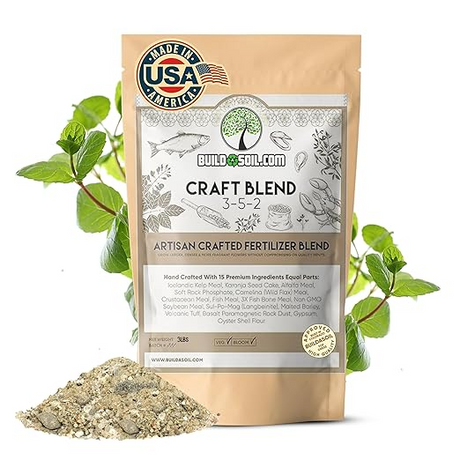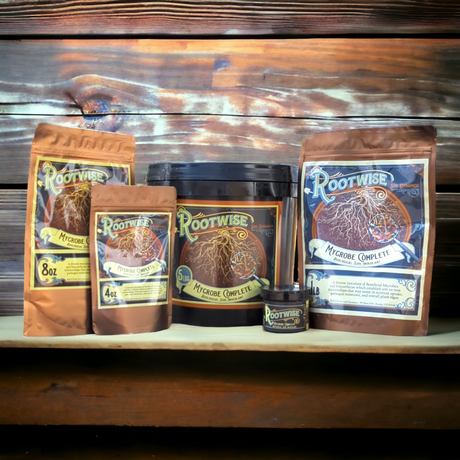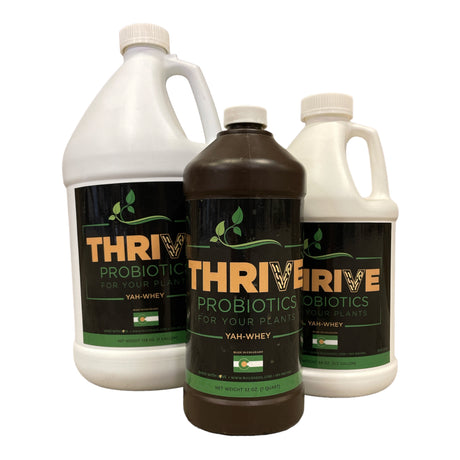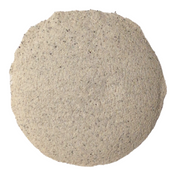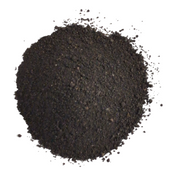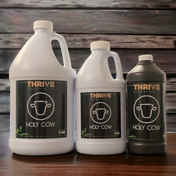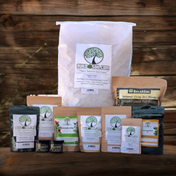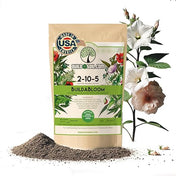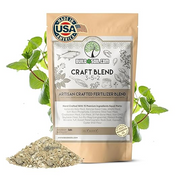All Beneficial Insect Combo Packs come with Free Shipping!
Please check the next tabs for more information on any of the insects offered in the combo packs.
NOT AVAILABLE FOR CANADA CUSTOMERS!!!!!
Notice: Beneficial Insects ship out immediately, within 1-7 business days, and sometimes the same day. BuildASoil will not be held accountable if insects arrive too early to be placed in soil.
support@buildasoil.com
The Beneficial Insect Triple Pack (Small) contains: Rove Beetle (100 Beetles) + Steinernema Feltiae Nematodes (50 Mil Tray) + Stratiolaelaps Scimitus (Hypoaspis Miles) (1/2 liter bottle - 12,500)
Rove Beetle (Dalotia Coriaria)

Rove beetle (Dalotia coriaria), formerly known as Atheta coriaria, is a native species of a soil-dwelling rove beetle which feeds on small insects and mites. Both adults and larvae are active aggressive predators and are attracted to decomposing plant or animal material and algae, where their hosts are found. While they are beetles, they do not necessarily look like beetles. They are light to dark brown in color, with adults being 3-4 mm long. They are slender with short wing covers. Rove beetles have an interesting habit of curving their abdomen upwards like scorpions and can run or fly when disturbed (usually close to the ground). Since they can actively fly, they rapidly colonize the release area. However, too many Atheta in flight may be because of disturbance to their home.
Use in Biological Control: Rove beetles are used primarily to assist in the control of shore flies and fungus gnats and other small arthropods in the soil or planting media. They also help control soil stages of thrips and feed on most other small soil organisms such as moth flies, springtails, and root mealybugs.
It has been used successfully in vegetable, bedding and potted plant production and seedling and cutting propagation. Atheta adapts well to the various growth media (including rockwool and coconut fiber) and capillary mats used in plant production. They will not survive freezing or flooding conditions.
Life Cycle: The complete life cycle of rove beetles is 21 days at 70°F (21°C), with relative humidity between 40 and 99%. The sex ratio is an equal, 1:1 females to males. Eggs hatch in 3-4 days into larvae, which resemble adults. Pupal chambers are constructed out of silk. Each adult rove beetle consumes 10-20 prey per day. In greenhouse conditions, adults are non-diapausing and can be used year round.
For Best Results: Rove beetle is most effective when applications are started before fungus gnat population becomes well established or while numbers are still low (less than one seen in a trap, per week). One application of Atheta per crop cycle is usually sufficient if started early in the season. Because rove beetle has a longer life cycle and takes longer to establish than the Stratiolaelaps predatory mite, so should be used along with Stratiolaelaps for best results.
Introduction Rates: Rove beetle is most effective when applications are started before fungus gnat populations become well established or while numbers are still low (below 10 per trap, per week). One application of rove beetle per crop cycle is usually sufficient if started early in the season. For soil culture, sawdust bag, or rockwool culture, apply 1 per 10 ft2 (1 m 2 ).
Target Pests: Shore flies (Ephydridae), fungus gnats (Sciaridae), western flower thrips (Frankliniella occidentalis), root aphids
Do not water soil or growing medium 10 minutes before and a few hours after release. To release, rotate the canister (to distribute beetles inside), then open the lid and release in centrally located area where major infestation is onto damp soil (only open when ready to release as they may fly away). Also distribute on floors, greenhouse weeds, under benches, and places where larvae will develop. Leave the canister on its side in the treatment area to ensure release of all mites. Release in the evening or late afternoon within 4 days of being received. Store canister on its side at 45-55° F.
How to Use:
Release throughout the greenhouse at a rate of 100- 1,000 per greenhouse weekly or biweekly, depending on greenhouse history of shore flies and fungus gnats. To ensure reproduction and mating, release 50-100 in one spot in the center of the release area. Be sure to treat areas with wet, exposed areas of soil where fungus gnats and shore flies are likely to breed.
Shipping Info:
Insects are shipped via UPS Overnight and may take 3 days to process.
In order to make sure we supply everyone with the freshest products available, we do not keep a rolling inventory (except sometimes Stratiolaelaps- which is subject to change). All bugs ship Monday through Thursday. No Friday shipments. Anything placed Friday will be shipped the following week. All bugs are overnighted.
Most Washington and Oregon orders may be shipped Ground, allowing for next day arrival. Any shipping outside of the Pacific Northwest will need to ship UPS 2nd Day or Next Day, depending on weather, location, and beneficial insect. Remember that we are working with a perishable product, and shipping methods reflect the need for your bugs to arrive to you alive and well.
Steinernema Feltiae Nematodes

Steinernema Feltiae Nematodes arrive ready-to-use. Just add to water and apply to the soil or growing media with virtually any watering device!
NemAttack Sf (Steinernema feltiae) Beneficial Nematodes are recommended to control and prevent mobile pests such as:
Fungus gnats, ticks, thrips, leafminers, caterpillars, cutworms, sod webworms, onion maggots, subterranean termites. American cockroach, armyworm, artichoke plume moth, Asian cockroach, beet armyworm, cabbage maggots, black cutworm, bluegrass weevil, codling moth, corn earworm, cotton bollworm, cucumber beetle, fall armyworm, fly larvae, fruit fly, German cockroach, mole crickets, tobacco budworm, wireworm and more.
Nematodes are shipped with an ice pack that will be melted when you receive it. Remove nematode package from insulated shipping container or packaging and place in refrigerator until you are ready to use them.
Beneficial Nematodes are live microscopic organisms (non-segmented round worms) that occur naturally in soil throughout the world. They are parasitic to insect pests that typically have a developing (larval or pupal) stage of life in the soil; however, they have been known to also parasitize above ground stages of adults, nymphs and larvae. They are completely safe to use and will not affect mammals, aquatic life, birds, reptiles or amphibians.After application, the nematodes immediately get to work. Upon finding a pest, they enter it through various body openings or directly through the body wall. Once inside, it is not the nematode that actually kills the pest, but the toxic bacteria inside the nematode's gut that is the real weapon symbiotic bacteria, that when released inside and insect, kill it within 24 - 48 hours by causing blood poisoning.
Beneficial Nematodes release the bacteria in order to create food and a hospitable environment for their own reproduction. As the food resources within the dead pest become scarce, the nematodes exit and immediately begin searching for a new host. As long as there is a suitable host, they will continue to survive and parasitize.
How Much Do I Need? Order enough to thoroughly treat your infested area. Some pests require multiple, separate treatments. Quantities and treatment areas are approximate.
| Garden Size |
Quantity |
Treatment Area |
Shipping Method |
| 1/2 Garden Size |
5 million |
1,600 sq. ft. |
2nd Day |
| Garden Size |
10 million |
3,200 sq. ft. |
2nd Day |
| Farm Size |
50 million |
1 Acre |
2nd Day |
| Small Ranch Size |
250 million |
5 Acres |
Next Day |
| Large Ranch Size |
500 million |
10 Acres |
Next Day |
| Important Shipping Note: |
When will my order ship?
• Orders ship Monday through Thursday. No Friday shipments and may take 3 days to process.
•
Any orders placed Friday will be shipped the following week.
•
All bugs are overnighted. If you would like the nematodes to ship on a specific date, please specify in the comments box in checkout.
• Nematodes cannot be shipped to Hawaii, Guam, Puerto Rico, US VI.
|
This Product Controls These Pests or Diseases:
This product works as a beneficial insect for control of the following: Fleas, Flies (mult), Fruit Flys (Drasophylla), Fungus Gnats (Bradysia impatiens), Gnats, Thrips (Franklinothrips sp)
Useful Info:
Warning & Toxicities: Do not freeze.
Shelf Life: Up to 2 weeks (refrigerated and unopened in original container).
How to Use:
How long can nematodes be kept before use?
Beneficial Nematodes should be used as soon as possible. Because they are live organisms, it is best to store them for no longer than 2 weeks in a refrigerator that is between 37° and 42° F.
How are nematodes applied?
The solution can be applied using a watering can, hose end sprayer, backpack or pump sprayer or through irrigation or misting systems.
When should they be released?
Release early in the morning or predusk when temperatures are cooler and the sun is not so bright.
Should the soil be moist after the nematode application?
The soil should be moist at time of application and lightly watered immediately after application. After application, regular watering of the treated area will provide sufficient moisture. Generally speaking, water every 3-4 days if rainfall does not occur.
What's the Application Rate?
It is best to make at least two applications, separated by 7-10 days in order to stagger the life cycles of the nematodes and to assure complete coverage. In cases of severe infestations, applications should be made every 7-10 days or until infestation subsides.
| Garden Size |
Quantity |
Treatment Area |
| 1/2 Garden Backyard Size |
5 million |
1,600 sq. ft. |
| Garden Size |
10 million |
3,200 sq. ft. |
| Farm Size |
50 million |
1 Acre |
| Small Ranch Size |
250 million |
5 Acres |
| Large Ranch Size |
500 million |
10 Acres |
How long does it take to see results?
In general 3-7 days for caterpillars such as cutworm, armyworm and sod webworm. For grubs and weevils such as Japanese beetle, black vine weevil and billbugs feeding stops within 3 days with maximum control occurring over 2-4 weeks. Nematodes disintegrate the pests from the inside out. You will not see dead insect bodies as you would with a chemical knockdown.
How often should nematodes be applied?
Nematodes are recommended for use whenever larvae or grubs are present. Generally, this is during the spring and fall months. Because larvae feed on plant roots, beneath the soil surface, severe damage can be done before realizing there is a problem. Look for signs of an adult insect, such as leaf-notching. If adult insects are present, their eggs will be hatching soon. Keep in mind, one application may not eradicate a population of insects that has become established over a period of years.
Will nematodes live through the winter?
In general, harsh winter weather in most parts of the country almost guarantees a significant decline in the population of the nematodes. In most cases, nematodes (just like insects) will become dormant during cold weather. Any survivors would be few in number to provide adequate insect control. If your insect pest returns the following year, another application may be necessary.
When nematodes are applied to one area will they move to other areas?
Nematodes, due to their microscopic nature have limited range of movement. Generally NemAttack™, our formulations of Steinernema will stay where you put them, but NemaSeek™ (Heterorhabditis) will continue moving through the soil until they find a pest to infect.
Warranty:
BuildASoil makes no guarantee of effectiveness due to subjectivity of application. BuildASoil guarantees live nematodes upon arrival of product and provides telephone backup for customer questions or problems.
Environment: Outdoors, Crops, Orchards & Vineyards, Nursery, Greenhouse, Grow Room, Hydroponics, Aquaponics, Pond & Environment, Household Use, Interiorscapes, Container Plants, Houseplants
Storage: Upon receipt remove outer packaging and store in a refrigerator (41°F/ 5°C ) but do not freeze. Ensure good air circulation around each tray. Use the entire tray contents at one time – do not use partial trays. Use before expiration date. To make a stock solution, dissolve 1 tray of Nemasys 50 million in 2 gallons of water. Allow the product to hydrate and disperse for at least five minutes. Keep agitated until all stock solution is used.
Shipping Info:
Insects are shipped via UPS Overnight or UPS 2-day.
| Garden Size |
Quantity |
Treatment Area |
Shipping Method |
| 1/2 Garden Size |
5 million |
1,600 sq. ft. |
2nd Day |
| Garden Size |
10 million |
3,200 sq. ft. |
2nd Day |
| Farm Size |
50 million |
1 Acre |
2nd Day |
| Small Ranch Size |
250 million |
5 Acres |
Next Day |
| Large Ranch Size |
500 million |
10 Acres |
Next Day |
Cannot Be Shipped To: HI,AK,PR,VI,GU,AS,PW or PO Boxes.
Stratiolaelaps Scimitus (Hypoaspis Miles)

For Developing Soil Stage Control of Thrips, Fungus Gnats and Springtails.
This tiny brown mite naturally inhabits the top layer of soil where larvae and pupae dwell. Female predatory mites lay their eggs in soil and the nymphs and adults feed on pests. If infestation is severe, use along with Beneficial Nematodes and Sticky Traps.
Release rates:
| Type of Application |
Release Rate |
| General Releases |
5,000-10,000 S. scimitus per 1,000 ft2 depending on level of infestation. |
| Large Area Releases |
25,000-50,000 S. scimitus per acre depending on level of infestation. |
| Weekly applications are recommended until infestations subside. Please call for more information. |
Note: The deadline for Stratiolaelaps scimitus Womersley or Hypoaspis orders is at 2 pm on Fridays of each week, for shipment the following week. We try to maintain a rolling inventory of this product so faster shipping is possible if the product is available.
This Product Controls These Pests or Diseases: Bean Thrips (Caliothrips fasciatus), Fungus Gnats (Bradysia impatiens), Springtails, Thrips (Franklinothrips spp)
Useful Info:
Shelf Life: Use within 18 hours of receipt. Do not water soil or growing medium 10 minutes before and a few hours after release. To release, rotate the canister (to distribute mites inside), then open the lid and remove the filter paper. Place the lid back on, and tap the mites out of the canister evenly onto the soil. Also distribute on floors, greenhouse weeds, under benches, and places where fungus gnat larvae will develop. Leave the canister and filter paper in the treatment area to ensure release of all mites. Release in the evening or late afternoon within 2 weeks of being received. Store canister on its side at 60-70° F.
How to Use:
General Applications: Incorporate mites into growing media at potting or sprinkle onto growing media surface. Rotate tube several times before opening to mix contents. To open lid, push the cut-out on the lid where marked. Rotate lid cover to fully open position for application. Shake tube slowly to dispense mixture onto the surface of growing media; mites will quickly distribute uniformly through crop.
Environment: Outdoors, Crops, Orchards & Vineyards, Nursery, Greenhouse, Grow Room, Interiorscapes, Container Plants
Storage: If not releasing immediately, keep in a cool dark place out of direct sunlight. Do not refrigerate. Top layer of soil, in a shaded area. 77°F
Shipping Info:
Shipping Restrictions:
Insects are shipped via UPS Overnight and may take 3 days to process.
In order to make sure we supply everyone with the freshest products available, we do not keep a rolling inventory (except sometimes Stratiolaelaps- which is subject to change). All bugs ship Monday through Thursday. No Friday shipments. Anything placed Friday will be shipped the following week. All bugs are overnighted.
Most Washington and Oregon orders may be shipped Ground, allowing for next day arrival. Any shipping outside of the Pacific Northwest will need to ship UPS 2nd Day or Next Day, depending on weather, location, and beneficial insect. Remember that we are working with a perishable product, and shipping methods reflect the need for your bugs to arrive to you alive and well.














